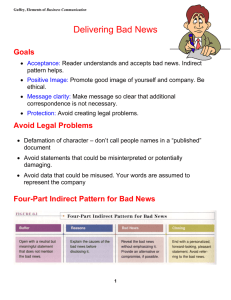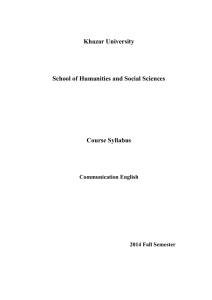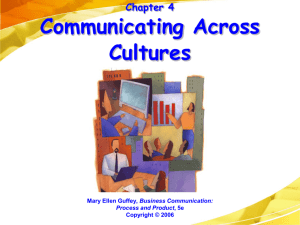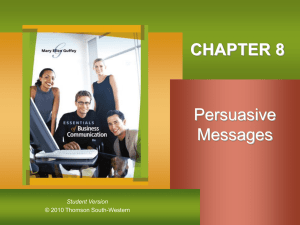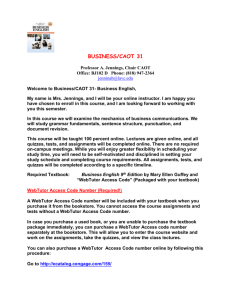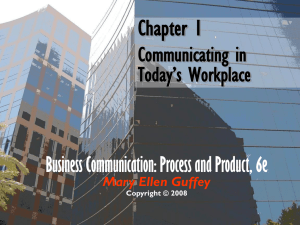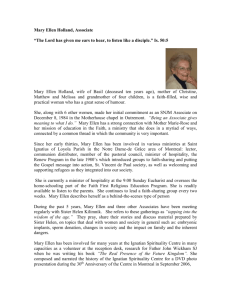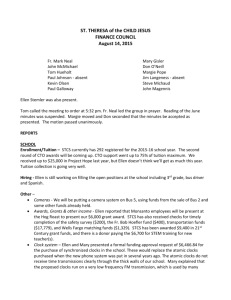Chapter 9 Persuasive and Marketing Messages
advertisement
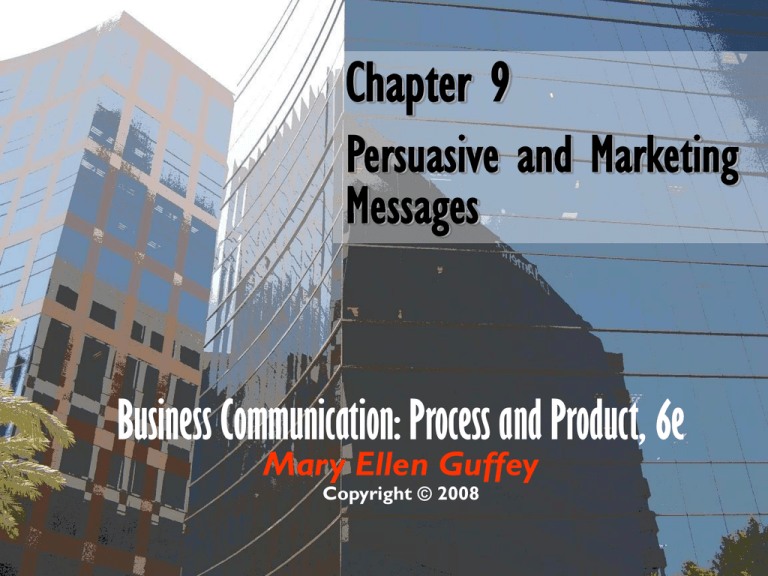
Chapter 9 Persuasive and Marketing Messages Business Communication: Process and Product, 6e Mary Ellen Guffey Copyright © 2008 Persuasive and Marketing Messages The Power of Persuasion The 3-x-3 Writing Process Persuasive Strategies, Format Typical Persuasive Documents Intercultural Persuasion Mary Ellen Guffey, Business Communication: Process and Product, 6e Ch. 9, Slide 2 Learning to Be Persuasive Mary Ellen Guffey, Business Communication: Process and Product, 6e © Mike Kemp / Rubberball Productions / Getty Images Persuasion is the ability to use argument or discussion to try to change an individual’s beliefs or actions. Ch. 9, Slide 3 What Persuasive Techniques Are Effective? Establishing credibility Making a reasonable, precise request Tying facts to benefits Recognizing the power of loss Expecting and overcoming resistance Sharing solutions and compromising Mary Ellen Guffey, Business Communication: Process and Product, 6e Ch. 9, Slide 4 What Techniques Improve Persuasion? Avoid sounding preachy or parental. Soften your words when persuading upward. Don’t pull rank. Avoid making threats. Be enthusiastic. Be positive and likeable. Mary Ellen Guffey, Business Communication: Process and Product, 6e Ch. 9, Slide 5 Applying the 3-x-3 Writing Process Analyzing the purpose What do you want the receiver to do or think? Prewriting Analyze Anticipate Adapt Anticipating the reaction Does the receiver need to be persuaded? Adapting to the audience How can you adapt your message to appeal to this receiver? Mary Ellen Guffey, Business Communication: Process and Product, 6e Ch. 9, Slide 6 Applying the 3-x-3 Writing Process Researching data Writing Research Organize Compose What information do you need? Where can you locate it? Organizing data Which strategy is better— direct or indirect? Mary Ellen Guffey, Business Communication: Process and Product, 6e Ch. 9, Slide 7 Applying the 3-x-3 Writing Process Revising Is the document clear and concise? Revising Edit Proofread Evaluate Proofreading Is the text correct? Evaluating Will the message achieve its purpose? Mary Ellen Guffey, Business Communication: Process and Product, 6e Ch. 9, Slide 8 Analyzing the Structure of Persuasive Messages Four-Part Persuasive Pattern: Gain Attention Build Interest Reduce Resistance Motivate Action Mary Ellen Guffey, Business Communication: Process and Product, 6e Ch. 9, Slide 9 Requesting Favors and Actions Prewrite Determine your purpose. Know exactly what you are requesting. Anticipate the reaction of your audience. Mary Ellen Guffey, Business Communication: Process and Product, 6e Ch. 9, Slide 10 Requesting Favors and Actions Gain Attention Use the indirect pattern rather than blurting out the request immediately. Begin with a problem description, unexpected statement, compliment, praise, related facts, stimulating question, or reader benefit. Mary Ellen Guffey, Business Communication: Process and Product, 6e Ch. 9, Slide 11 Requesting Favors and Actions Build Interest Develop interest by using facts, statistics, examples, testimonials, and specific details. Establish your credibility, if necessary, by explaining your background and expertise. Tie facts to direct and indirect benefits Mary Ellen Guffey, Business Communication: Process and Product, 6e Ch. 9, Slide 12 Direct and Indirect Benefits Direct Benefit If you accept our invitation to speak, you will have an audience of 50 potential customers for your products. Indirect Benefit Your appearance would prove your professionalism and make us grateful for your willingness to give something back to our field. Mary Ellen Guffey, Business Communication: Process and Product, 6e Ch. 9, Slide 13 Requesting Favors and Actions Reduce Resistance Anticipate objections and provide counter-arguments. Suggest what might be lost if the request is not granted. In requesting favors or making recommendations, show how the receiver or others will benefit. Mary Ellen Guffey, Business Communication: Process and Product, 6e Ch. 9, Slide 14 How to Reduce Resistance Example Although your gift to Neonatal Care Center is not tax deductible, it would help us purchase one Intensive Care Ventilator.This unit would be put to use immediately in caring for critically ill and premature newborn infants. Mary Ellen Guffey, Business Communication: Process and Product, 6e Ch. 9, Slide 15 Requesting Favors and Actions Motivate Action Make a precise request; include a deadline. Repeat a benefit, provide details, or offer an incentive. Mary Ellen Guffey, Business Communication: Process and Product, 6e Ch. 9, Slide 16 Dear Dr. Thomas: “Before”—Ineffective Request Because you know Atlanta and live here in our town, we thought about asking you to speak at our GSU Business Awards banquet April 28. A few students on campus have read and admired your book Beyond Race and Gender, which appeared last spring and became a bestseller across the nation. We were amazed that a local author is now the nation’s diversity management guru. But what exactly did you mean when you said that America is no longer a melting pot of ethnic groups—it’s an “American mulligan stew”? Georgia State University doesn’t have any funds for honoraria, so we can invite only local speakers. The Reverend James R. Jones and Vice Mayor Rebecca A. Timmons were speakers in the past. Our awards banquet gets started at 6 p.m. with a social hour, followed by dinner at 7 and the speaker from 8:30 until 9. If you require, we can arrange transportation for you and your guest. Although you are a very busy person, we hope you will agree to this invitation. Thank you in advance. Please notify our advisor, Professor Alexa North. Sincerely yours, Mary Ellen Guffey, Business Communication: Process and Product, 6e Ch. 9, Slide 17 Critical Thinking Questions 1. What is the purpose of the letter? 2. How do your think the reader will react to the message? 3. What could be used to attract the attention of the reader in the opening? Write an appropriate opening. 4. What information could be used to build interest in the body? Mary Ellen Guffey, Business Communication: Process and Product, 6e Ch. 9, Slide 18 Critical Thinking Questions 5. What are some of the arguments the receiver might offer to resist the invitation? Could any counter-arguments be offered? 6. What could be used to motivate the reader to accept? 7. Should an end date be used in the closing? What information could be added to the closing to make it easier for the receiver to respond? Write an appropriate closing. Mary Ellen Guffey, Business Communication: Process and Product, 6e Ch. 9, Slide 19 Dear Dr. Thomas: “After”—Improved Request Your book Beyond Race and Gender stimulated provocative discussion across the nation and on our campus when it first appeared last spring. Business students at Georgia State University now consider you the nation’s diversity management guru, and for that reason they asked me to use all my powers of persuasion in this invitation. Because we admire your work, we would like you to be our keynote speaker at the GSU Business Awards banquet April 28. As students at an urban campus in a metropolitan area, we are keenly aware of diversity issues. In your words, America is no longer a melting pot of ethnic groups; it is now an “American mulligan stew.” We would like to hear more about the future workforce and how managers can maximize the contribution of all employees. Although we can’t offer you an honorarium, we can promise you a fine dinner at the GSU Faculty Club and an eager and appreciative audience of over 100 business students and faculty. Speakers in the past have included the Reverend James R. Jones and Vice Mayor Rebecca A. Timmons. Mary Ellen Guffey, Business Communication: Process and Product, 6e Ch. 9, Slide 20 Dr. Thomas Page 2 Current date The evening includes a social hour at 6 p.m., dinner at 7 p.m., and your remarks from 8:30 until 9. So that you won’t have to worry about transportation or parking, we will arrange a limousine for you and your guest. Please make this our most memorable banquet yet. Just call our adviser, Professor Alexa North, at 356-9910 before April 5 to accept this invitation. Sincerely yours, Mary Ellen Guffey, Business Communication: Process and Product, 6e Ch. 9, Slide 21 Persuading Within Organizations Prewrite Know your purpose. Make sure it’s doable and attainable. Profile the audience. Play What if scenarios to anticipate the receiver’s reactions. Mary Ellen Guffey, Business Communication: Process and Product, 6e Ch. 9, Slide 22 Persuading Within Organizations Gain Attention Use one of the following techniques: Make the reader aware of a problem. Use a startling statement. Provide a significant fact related to the request. Describe possible benefits. Ask a stimulating question. Offer compliments. Establish credibility but don’t pull rank. Mary Ellen Guffey, Business Communication: Process and Product, 6e Ch. 9, Slide 23 Persuading Within Organizations Build Interest Use facts, statistics, examples, and details to build a solid foundation for your request. Strive for a personal but professional tone. Soften your words when persuading upwards. Mary Ellen Guffey, Business Communication: Process and Product, 6e Ch. 9, Slide 24 Persuading Within Organizations Reduce Resistance Recognize any weakness in your proposal and suggest well-reasoned counter-arguments. In requests flowing upward, consider a strong dollar-and-cents appeal for requests involving budgets. In requests flowing downward, avoid sounding preachy, parental, or overly authoritarian. Mary Ellen Guffey, Business Communication: Process and Product, 6e Ch. 9, Slide 25 Persuading Within Organizations Motivate Action State a specific request including a deadline, if appropriate. Suggest ways to make the response effortless and painless. Repeat a major benefit. Include an incentive or reason to act. Express appreciation, if appropriate. Mary Ellen Guffey, Business Communication: Process and Product, 6e Ch. 9, Slide 26 How to Write a Good Complaint Letter Begin with a compliment, point of agreement, statement of the problem, or brief review of the action you have taken to resolve the problem. Provide identifying data. Prove that your claim is valid; explain why the receiver is responsible. Enclose document copies supporting your claim. Mary Ellen Guffey, Business Communication: Process and Product, 6e Ch. 9, Slide 27 How to Write a Good Complaint Letter Appeal to the receiver’s fairness, ethical and legal responsibilities, and desire for customer satisfaction. Describe your feelings and your disappointment. Avoid sounding angry, emotional, or irrational. Close by telling exactly what you want done. Mary Ellen Guffey, Business Communication: Process and Product, 6e Ch. 9, Slide 28 Writing Sales Letters Prewrite Analyze your product or service: What makes it special? What central points should you emphasize? How does it compare with the competition? Mary Ellen Guffey, Business Communication: Process and Product, 6e Ch. 9, Slide 29 Writing Sales Letters Prewrite Profile your audience. How will this product or service benefit this audience? Decide what you want the audience to do at the end of your message. Mary Ellen Guffey, Business Communication: Process and Product, 6e Ch. 9, Slide 30 Writing Sales Letters Gain Attention Describe a product feature, present testimonials, show the reader in an action setting, or make a startling statement. Example: How much is sex costing your company? An incident of sexual harassment can cost millions of dollars unless preventive measures are taken. Offer something valuable, promise a significant result, or describe a product feature. Mary Ellen Guffey, Business Communication: Process and Product, 6e Ch. 9, Slide 31 Writing Sales Letters Build Interest Describe the product in terms of what it does for the reader. Show how the product or service saves or makes money, reduces effort, improves health, produces pleasure, or boosts status. Example: Our computer-based training program teaches your employees what behavior is acceptable and unacceptable, while showing you steps to reduce the risk of employer liability. Mary Ellen Guffey, Business Communication: Process and Product, 6e Ch. 9, Slide 32 Writing Sales Letters Reduce Resistance Counter anticipated reluctance with testimonials, attractive warranties, trial offers, free samples, or money-back guarantees. Example: This important investment in sexual harassment prevention comes with a money-back guarantee. If you are not satisfied, your entire training costs are returned. Mary Ellen Guffey, Business Communication: Process and Product, 6e Ch. 9, Slide 33 Writing Sales Letters Reduce Resistance Build credibility with results of performance tests, polls, or awards. If price is not a selling feature, describe it in small units, show it as savings, or tell how it compares favorably with the competition. Mary Ellen Guffey, Business Communication: Process and Product, 6e Ch. 9, Slide 34 Writing Sales Letters Motivate Action Close with repetition of the central selling point and clear instructions for an easy action to be taken. Prompt the reader to act immediately with a gift, incentive, limited offer, or deadline. Mary Ellen Guffey, Business Communication: Process and Product, 6e Ch. 9, Slide 35 Writing Sales Letters Motivate Action Put the strongest motivator in a postscript. Example: P. S. Sign up now and you receive a free 60-day trial. Call, fax, or e-mail us today to receive a free demo disk. You can’t lose! Mary Ellen Guffey, Business Communication: Process and Product, 6e Ch. 9, Slide 36 Persuasive Techniques in High-Context Cultures Asia South America Africa Collectivist view Indirectness The Middle East Politeness High-Context Cultures Relationship appeal, long-term goal Soft-Sell Approach Mary Ellen Guffey, Business Communication: Process and Product, 6e Ch. 9, Slide 37 Persuasive Techniques in Low-Context Cultures Scandinavia Northern Europe “You” view Short-term goal North America Directness Low-Context Cultures Australia Superlatives Hard-Sell Approach Mary Ellen Guffey, Business Communication: Process and Product, 6e Ch. 9, Slide 38 End Mary Ellen Guffey, Business Communication: Process and Product, 6e Ch. 9, Slide 39
